 |
 |
 |
| |
Inhibitors of the RNase H Activity of Reverse Transcriptase as an Approach to New HIV-1 Antiretroviral Agents: Merck program
|
| |
| |
P. D. Williams,a D. D. Staas,a S. Venkatraman,a T. M. Booth,a H. M. Loughran,a
R. D. Ruzek,a J. S. Wai,a J. P. Vacca,a S. Prasad,b
S. K. Munshi,b C. Bahnck,c G. Dornadula,c R. C. Hrin,c A. L. Himmelberger,c M. D. Miller,c D. J. Hazuda,d J. A. Grobler,c
Departments of aMedicinal Chemistry, bStructural Biology, cAntiviral Research, dInfectious Diseases Administration, Merck & Co., Inc., West Point, PA 19486 USA
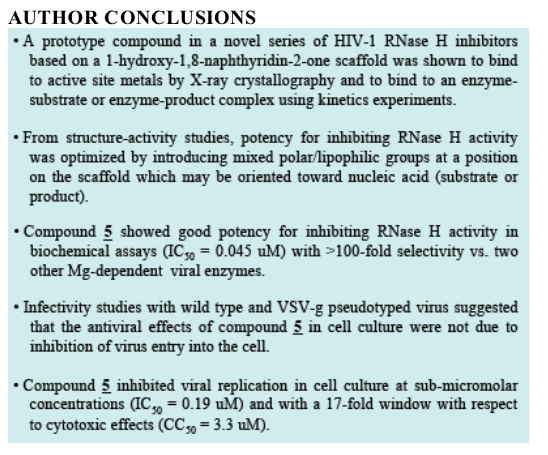
Abstract
A novel series of HIV-1 RNase H inhibitors has been developed. A prototype inhibitor was shown to bind to two manganese ions in the RNase H active site of full length RT by X-ray crystallography. Systematic structure-activity studies around the core structure identified substituents which improved potency and selectivity in biochemical assays and antiviral activity in cell culture. An optimal compound from this work, inhibitor 5, showed good potency and selectivity in biochemical assays (RT RNase H IC50 = 0.045 uM, RT Polymerase IC50 = 13 uM; Integrase Strand Transfer IC50 = 24 uM) and antiviral effects in cell culture (IC50 = 0.19 uM) with a 17-fold window with
respect to cytotoxicity (CC50 = 3.3 uM).
INTRODUCTION
Nucleoside and non-nucleoside HIV-1 reverse transcriptase (RT) inhibitors are widely prescribed agents for the treatment of HIV infection. Both drug classes work by interfering with the polymerase function of RT. In addition to the polymerase active site, RT contains a ribonuclease H (RNase H) active site which hydrolyzes RNA phospho- diester bonds in RNA-DNA duplexes produced during reverse transcription. Viruses with inactivating mutations in the RNase H active site fail to replicate, thus demonstrating an essential role of the RNase H activity and raising considerable interest in the identification of an RNase H inhibitor as a mechanistically novel antiretroviral
agent.
We recently identified a novel series of HIV-1 RNase H inhibitors based on a 1-hydroxy-1,8-naphthyridin-2-one scaffold. Lead compound 1 exhibited good activity as an RNase H inhibitor in a biochemical assay (IC50 = 0.1 uM).
Herein we report optimization efforts and mechanism-of- action studies with inhibitors in this novel structural class.
Methods and Results
Figure 1
X-ray crystal structure showing binding of compound 1 to two Mn 2+ ions (purple) in the RNase H active site of HIV-1 reverse transcriptase.
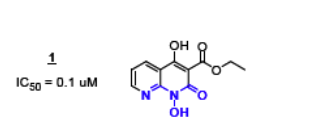
Figure 2
Double reciprocal plot of velocity vs. substrate concentration showed mixed-type inhibition of RNase H activity by compound 1, indicating that 1 binds to an
enzyme-substrate or enzyme-product complex.
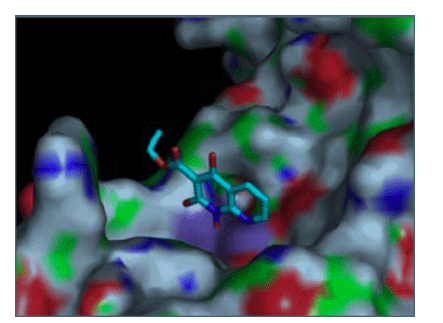
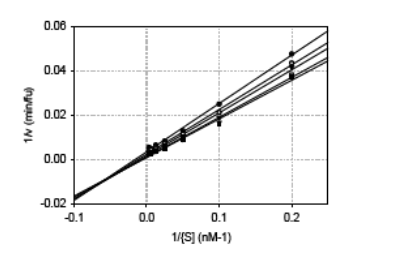
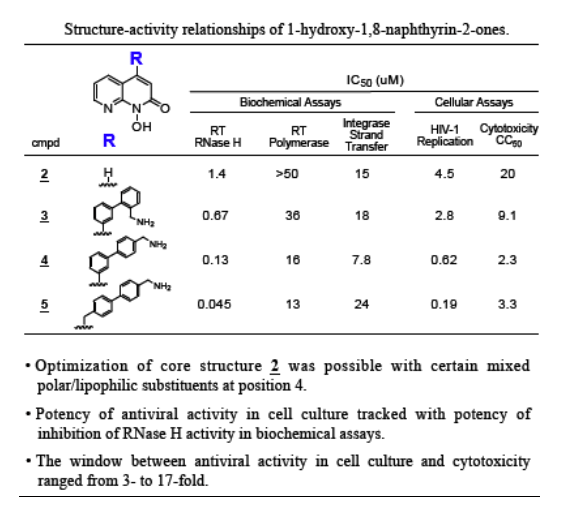
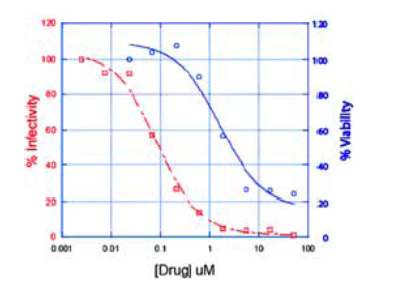
Figure 5
Equivalent dose-response curves using wild-type HIV-1 (blue) and VSV-g pseudotyped virus (red) indicated that the antiviral effects of compound 5 are not due to inhibition of virus entry into the cell.
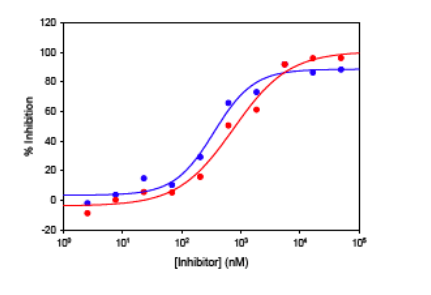
|
| |
|
 |
 |
|
|